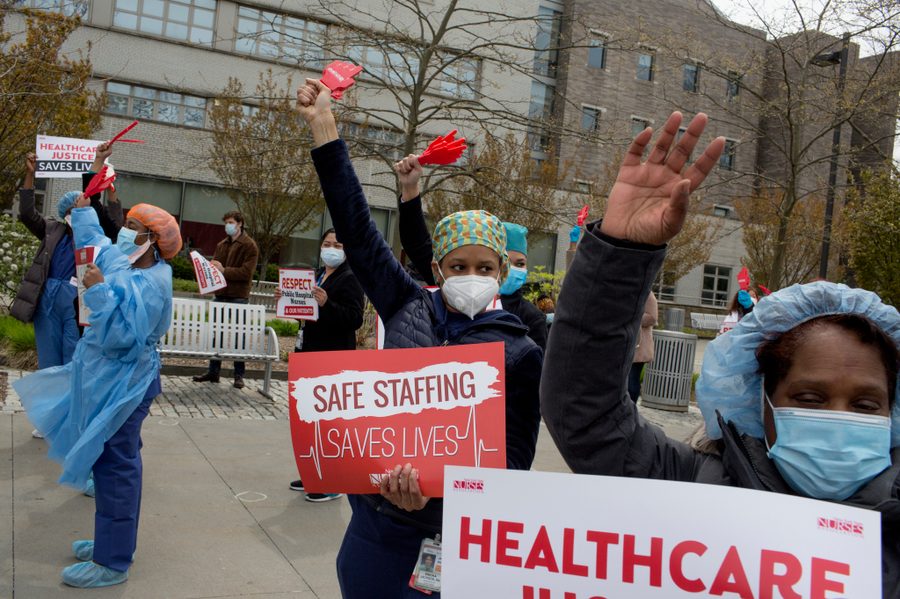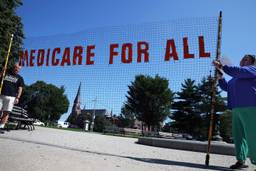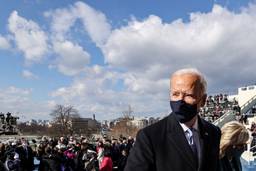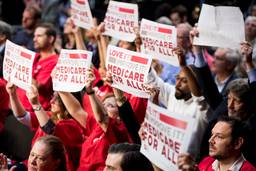Nurses Set To Strike Against New York City’s Healthcare Monopolies
Decades of mergers and acquisitions have turned New York’s hospitals into profit-oriented corporations. Nurses are fighting to change that.
Michael Lighty

Update: As of Monday, over 7,000 nurses are on strike at Mount Sinai Hospital and Montefiore Medical Center.
On New Year’s Eve, the New York State Nurses Association (NYSNA) announced that nearly 17,000 nurses at eight major New York hospitals planned to begin a strike January 9 if management did not meet their demands for increased staffing, fair compensation and health and safety protections. After the strike was authorized, hospitals began making substantial wage and staffing offers, leading to three bargaining units representing about 7,000 nurses settling contracts in the past week. But nurses at five hospitals, including Montefiore Medical Center, Mount Sinai Hospital and Mount Sinai Morningside, remain on the brink of what could become one of the largest nurses’ strikes in recent years.
The potential strike comes at a time when nurses are overwhelmed by a “tripledemic” of Covid, flu and Respiratory Syncytial Virus Infection (RSV), but the issues animating the struggle are older, rooted in the creation of mega healthcare systems over the past decade. A 2018 New York Times report shows that the nation’s hospitals have been consolidating at an exponential rate, forming a monopolistic healthcare system. Mergers and acquisitions put market power firmly in the hands of large hospital systems, which hike up prices knowing that insurance companies will pay to keep those facilities in their networks. Insurers then pass the financial burden onto patients. The Times report found that prices for an average hospital stay have gone up between 11% and 54% because of healthcare consolidation.
From 2015 to 2019, U.S. hospitals’ net patient revenue increased by $8.6 million per year on average. By 2022, the top 25 hospitals in New York alone averaged an annual net patient revenue of close to $2 billion. These mergers have turned independent community hospitals into “nonprofit” conglomerates — “nonprofit” in their tax status, but profit-centric in every decision that counts. “My hospital, once a humanitarian institution, now behaves like a profit-driven corporate entity,” says Judy Sheridan-Gonzalez, a past president of NYSNA and an emergency room nurse in the Bronx with 40 years of experience. Sheridan-Gonzalez’s hospital has been aggressively acquiring smaller community hospitals for years. “It cuts staff and services to the Bronx, the county with the worst health indices in the state, investing instead in real estate and lucrative endeavors.”
Per a Crain’s New York analysis, “the consolidation strategy has given rise to increasingly flush megasystems of hospitals concentrated in whiter, wealthier areas of the city. During the past 25 years, 20 hospitals have closed across the city, amounting to a loss of about 5,800 beds.” In addition to wholesale hospital closures in poor neighborhoods, hospital managers’ newfound emphasis on increasing profits has led to other cost-cutting measures such as hiring fewer staff nurses and not buying sufficient personal protective equipment (PPE). Those decisions have created unsafe working conditions and extreme burnout. The pandemic exacerbated these issues, and even though many hospitals received Covid relief funding, this did not translate into sufficient PPE, better staffing or improved working conditions.
Instead, the effects of a monopoly health system have continued: high executive salaries and segregated units where VIPs get concierge services and specialty care,while the majority of wards are understaffed. Managers within the conglomerated health system also began to use rising profits to fuel more acquisitions, leading to a cycle of hospitals serving the rich at the expense of local communities which had relied on them.
In New York hospitals, these profit-maximizing practices have left Intensive Care Units (ICUs) unequipped to handle the winter surge of patients, especially children, suffering from various repository illness at record levels. In a statement put out by the NYSNA, Aretha Morgan, a pediatric emergency room nurse at New York-Presbyterian, said: “Our pediatric ER is overflowing and short-staffed on almost all shifts. It is unbearable to see children suffer because we don’t have enough staff to provide safe patient care.”
Nurses have been fighting back. In 2021, the New York state legislature passed and the governor signed a NYSNA-initiated hospital staffing bill mandating a limit of two ICU patients per nurse and requiring hospital management to negotiate such limits with a committee of nurses for all units of the hospital. The legislation, which was the result of decades of nurses’ organizing, represented a significant win for the NYSNA, but its implementation has been delayed thanks to successful lobbying by New York City’s hospital conglomerates. The one-to-two ICU ratio was supposed to have been enforced by the state health department in January 2022, but a year after that deadline, staffing levels continue to be set by budget rather than by patient need — an issue which in part motivated the nurses’ strike vote. Nurses routinely provide care to three and sometimes four critically ill patients in the ICU, when the standard is at most two. Given the severity of illness, it should often be one-to-one.
Jessica Montanaro, a nurse in Mount Sinai Morningside’s intensive care unit, told New York Focus that chronic understaffing was causing burnout among nursing staff, leading to many nurses leaving to pursue less stressful forms of nursing. She said those nurses have not been replaced, leading to a further staffing shortage. “We’re kind of standing up as a profession and we’re saying, ‘Look, we’re not OK. We don’t have the support. We’re in these untenable ratios. It’s not safe for our mental or physical health or the patient’s safety,’ ” Montanaro said. “And yet it’s not being heeded for whatever reason.”
Decades of legislative activism and multiple rounds of contract bargaining have yet to create a safe hospital environment for nurses and patients, leaving NYSNA nurses with no alternative but to strike. In addition to safe staffing levels, nurses are demanding fair wages, no cuts to their health coverage, and health and safety protections in light of the tripledemic of Covid, RSV and flu. They also want community benefits, such as funding programs to recruit and train nurses from within the communities they serve.
Sheridan-Gonzalez summed up the process and the stakes, saying, “We testified about the brutal inequities that were exacerbated before, during and after the worst of the Covid pandemic … but no one listened. We now take the drastic step to go out on strike so that maybe, finally, someone will hear us.”
The NYSNA nurses’ impending strike is a challenge to the business model of hospital consolidations and to the elimination of community-based healthcare services. The need for nursing care is why patients go into a hospital. Nurses can use that power on behalf of communities abandoned and disregarded by the hospital monopolies. If they cannot undo the mergers, the nurses can at least re-establish community health and professional safety standards. To demand and win safe staffing and patient care practices is a vital community benefit. And as potential patients, we all have a stake in their struggle.
Michael Lighty, a Sanders Institute Fellow and DSA activist, is a consultant for the National Union of Healthcare Workers.







